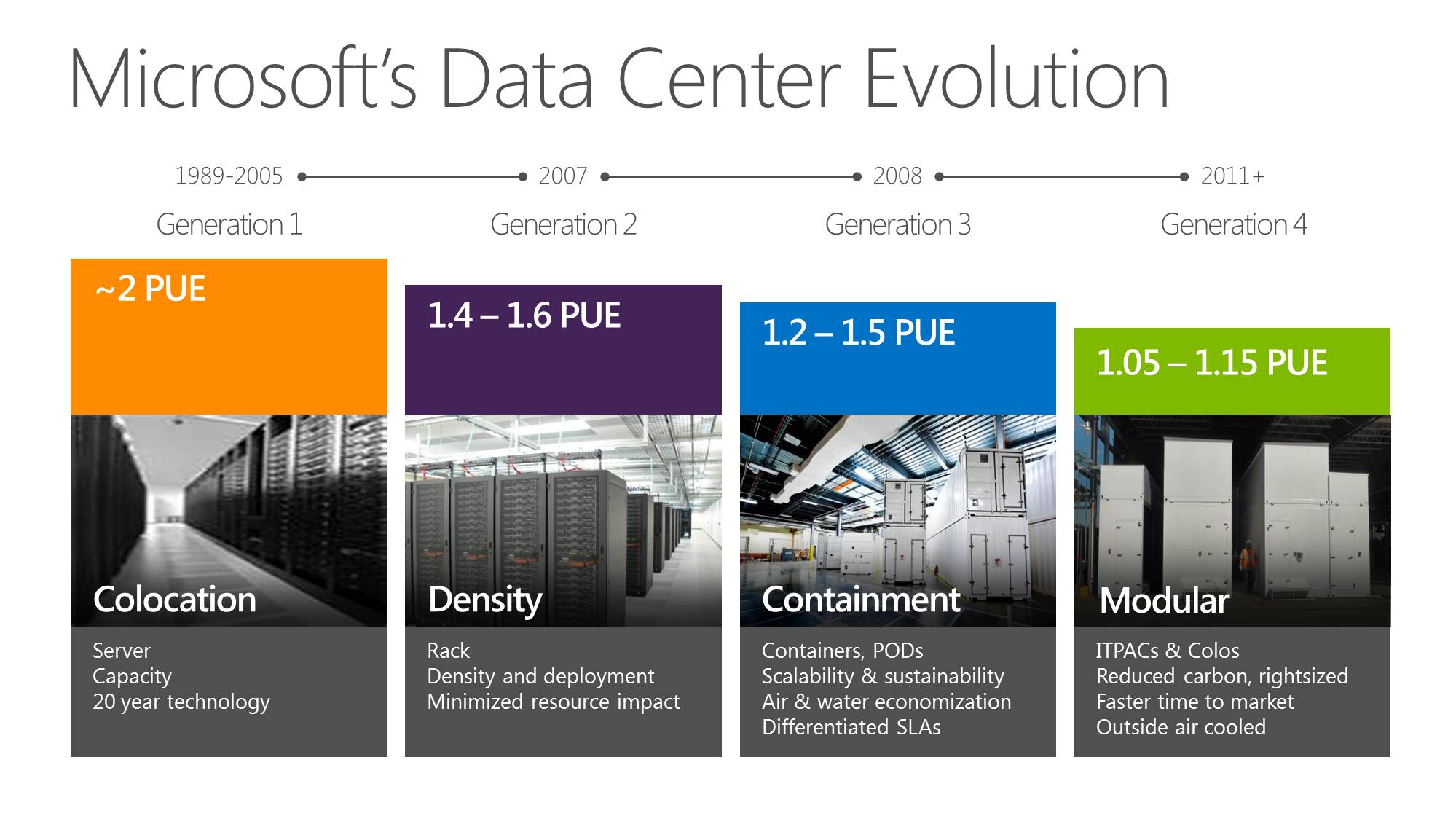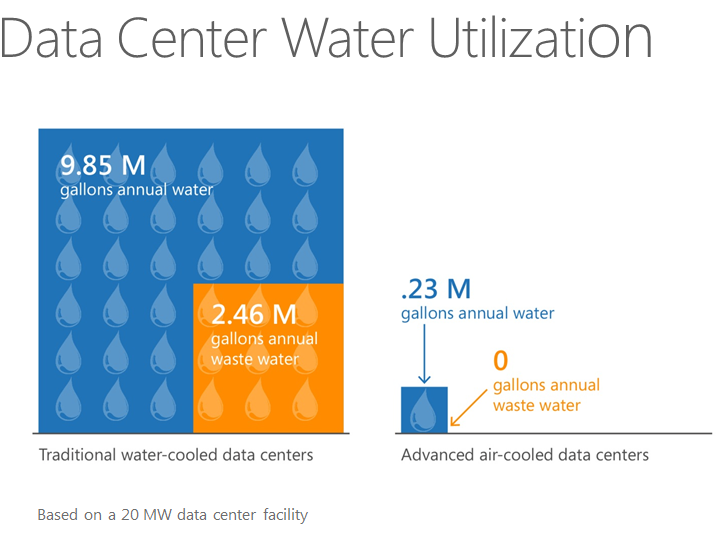Microsoft’s Energy and Efficiency Evolution to Power the Cloud
 Brian Janous, Utility Architect
Brian Janous, Utility Architect
Data Center Advanced Development
From search engines like Bing and Google, to social media like Facebook and Twitter, to hosted services on Azure and other platforms, to a wide range of cloud services like Office 365, Xbox Live and Hotmail, online services are a critical part of our lives, and they will only get more prevalent and indispensable in the years ahead. Today, Microsoft delivers more than 200 online services to 1+ billion customers and 20 million businesses in over 76 markets worldwide. The data centers that provide these services require constant and reliable energy to operate, and the purchase of energy is one of a data center's single largest expenditures. For these reasons, energy sourcing has long been a focus at Microsoft. We are committed to constantly improving our energy sourcing practices so that we use the most reliable, affordable, and sustainable energy to power the search, productivity tools and cloud services on which our customers depend.
I joined Microsoft's Data Center Advanced Development team in late 2011. Our mandate is to continuously improve how our data centers source power in order to reduce costs and improve reliability and sustainability for Microsoft's online services. My team is working on solutions that will result in a more sustainable energy supply for Microsoft's data centers, which includes minimizing all resource requirements, including power consumption, water usage, and carbon emissions.
Microsoft's data center efficiency is the result of our culture that is focused on building sustainability in from the ground up. This began with our first data center in 1989. Since that time, we have continually reduced our demand for power and water in our new and existing data centers. Data center efficiency is often measured using power usage effectiveness (PUE), a ratio of total data center power consumption to server-related power consumption. PUE is a measure of how much power is needed to run a process through a data center. PUE in our latest data centers are some of lowest in the industry, at 1.05-1.15.
In addition, we continue to pioneer innovations to reduce water usage. Water has traditionally been used in data center cooling systems. However, our latest air-cooled data centers in Iowa, Ireland, Virginia, and Washington are designed to use 1-3 percent of the water required for a traditional data center, and the only water loss in these new systems is through evaporation, resulting in no waste water. These innovations in Microsoft data center efficiency evolution have served as a model to help others in the industry achieve similar reductions in power and water usage in their latest designs.
While we are continually developing ways to reduce the amount of power we consume, we are also focused on the source of that power and the associated carbon intensity. Microsoft committed to achieve carbon neutrality as of July 1, 2012. Under this policy, each business unit is responsible for the carbon that it generates, giving every business unit a direct financial incentive to reduce their carbon footprint. With respect to data centers, this means that all of the carbon emissions associated with our power consumption is now being offset by corresponding purchases of renewable energy or carbon offsets. (Microsoft's approach to achieving carbon neutrality is a significant step forward in that the cascading of costs through the organization ensures that carbon is considered as a cost factor in the end-to-end life cycle of our data centers, from design, to siting, to operations).
We have also been evaluating more sustainable solutions to supply power to our data centers through both on-site generation and long term purchases from larger grid-connected installations that would displace some portion of our grid purchases. As indicated in the graphic below, whether we add power to the system from large grid-connected power plants, or we consume power directly from on-site projects, the net impact is similar in that we reduce dependence on a carbon intensive supply chain.
-
Biomass generation project in Europe that would operate on waste fuel
- Large photovoltaic solar project in the Southwestern U.S.
- Fuel cell installation that would improve reliability and eliminate the need for back-up diesel generators in situations where the power grid goes down
- Combined heat and power (CHP) projects that capture waste heat for reuse
In addition to these projects, we are also seeking ways to more efficiently access the market for clean energy projects that meet our cost and carbon reduction goals. We have recently signed on as an advisory board member with Altenex, an operator of a network that enables member companies to more efficiently engage with developers of renewable energy projects. We expect this engagement with Altenex to improve our ability to identify and evaluate cost-effective clean energy projects.
In addition to the source of our power, we are also focused on the issue of power availability. We have previously discussed our Data Plant initiative. This initiative will enable us to reduce our reliance on traditional unreliable energy infrastructure through combining data center and power generation operations. We expect our work in this area to reveal opportunities to reduce costs, improve reliability, and reduce emissions associated with our data center operations. However, today, nearly all of the electricity that Microsoft data centers consume is supplied from a local power grid. Given the unreliability of the electric grid and the need for continuous availability of cloud services, Microsoft maintains diesel generator backup at all of our data centers, as is typical across the industry. Our policy is to use these backup generators only when necessary to help maintain grid stability or in extraordinary repair, and maintenance situations that require us to take our data centers off the power grid. These generators are inefficient and costly to operate. From both an environmental and a cost standpoint, it makes no sense to run our generators more than we absolutely must. We are currently exploring alternative backup energy options that would allow us to provide emergency power without the need for diesel generators, which in some cases will mean transitioning to cleaner-burning natural gas and in other cases, eliminating the need for back-up generation altogether.
What does all of this mean for the consumer of Microsoft's services?
- Our high level of efficiency means that utilizing the Microsoft cloud results in less energy being consumed per process than the industry average, leading to lower costs and less environmental impact.
- Our commitment to carbon neutrality means that we will aggressively pursue new opportunities to integrate clean energy into our power supply.
- Our commitment to innovation means that we are continually improving the reliability, affordability and sustainability of our data centers and cloud services
We look forward to sharing our progress in future posts on these initiatives as well as on our continued research into how to leverage on-site generation to improve reliability and lower costs.
For more information on our datacenter sustainability, please visit our website.



